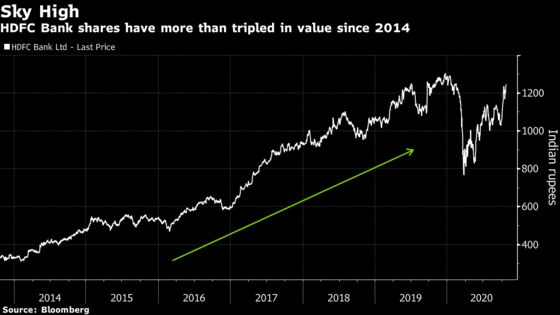The Lone Bear on India’s Biggest Bank Shrugs Off Profit Beat
Pankaj Agarwal has mostly stuck to his sell rating on HDFC Bank for six years.

(Bloomberg) -- Pankaj Agarwal has mostly stuck to his sell rating on HDFC Bank Ltd. for six years, during which the lender’s stock has tripled in value, turning it into India’s biggest by market capitalization.
Yet investors who followed Agarwal’s recommendations over the past 12 months have yielded a 34% return, the most among more than 40 analysts covering the stock.
After a rebound of about 63% from its March low, HDFC Bank’s stock is too expensive given the risks related to management change and asset quality, as Indian lenders face “one of the most challenging phases” amid Covid-19 and the nation’s prolonged credit crisis, Agarwal, an analyst at Ambit Capital Pvt, said in an interview. He has had a sell rating on HDFC Bank since 2014 save a brief upgrade to buy earlier this year, Bloomberg-compiled data show.
Bank stocks have been the worst-performers in India this year, with a gauge of lenders down 24% versus a 1.6% loss for the benchmark S&P BSE Sensex. Soured loans are expected to swell to the highest level in more than two decades in 2021 following the world’s strictest lockdown measures.
HDFC Bank posted profit for the September-ended quarter that beat the average analyst estimate by 17%. Its gross bad-loan ratio narrowed, but that was thanks to regulatory exemptions that make it difficult to read asset quality trends, Agarwal said.

India’s largest private lender is trading at 3.6 times book value, more than double the valuation of any other bank globally with a market cap of over $50 billion. The stock is down just 2% this year, outperforming all of its peers on the S&P BSE Bankex Index. But investors are missing the point, according to Agarwal.
“The external environment is weak, a lot of veterans are no longer with the bank and the risk on its balance sheet is higher than before in terms of both retail and corporate loans,” the Mumbai-based analyst said.
Returns based on analyst recommendations are calculated assuming that each independent recommendation change is a new investment of equal size. All positive analyst ratings are mapped to an equally-sized long positions in the security and all negative ratings are mapped to equally-sized short positions in the security.
Agarwal is the only analyst with a sell rating of the 56 tracked by Bloomberg, and his target price of 1,012 rupees implies a decline of about 19% from current levels.
Rising Risks
The lender’s Chief Executive Officer Aditya Puri is set to pass the baton after almost three decades to Sashidhar Jagdishan later this month. There is “reasonable probability” that HDFC Bank’s new management will find it difficult to replicate previous success, Agarwal said.
The lender has outpaced growth in India’s overall banking sector, but faces a shrinking economy amid the pandemic.
In the September quarter, HDFC Bank’s loan growth was boosted by a 26.5% rise in its wholesale book -- primarily money lent to companies -- but its retail loan book slowed sharply to 5.3% from 14.7% a year earlier.
Agarwal expects the bank to face higher credit costs as bad debt builds in its corporate and retail loan businesses because of exposure to stressed sectors including shadow banks, real estate, transportation and unsecured loans. It’s the “best bank in the country” but shouldn’t trade at such a high premium to other lenders, he said.
©2020 Bloomberg L.P.